PRISMA系统评价方法.ppt
- 格式:ppt
- 大小:473.55 KB
- 文档页数:39
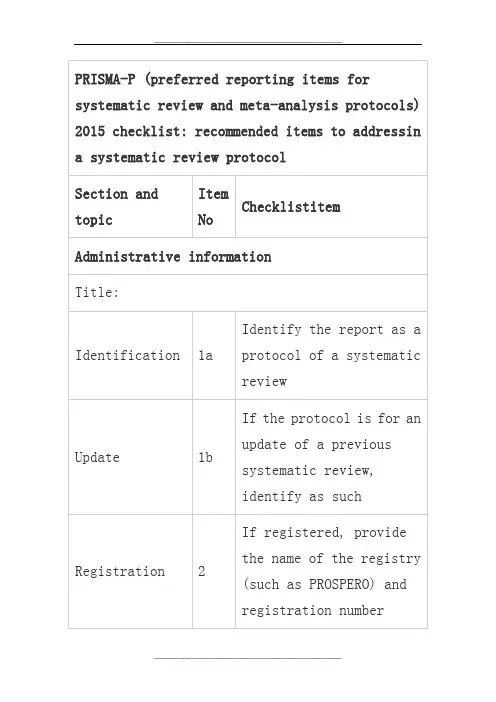
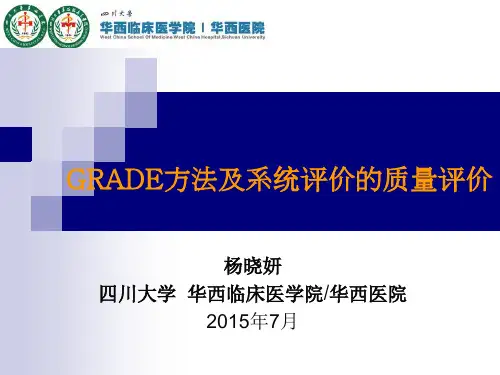
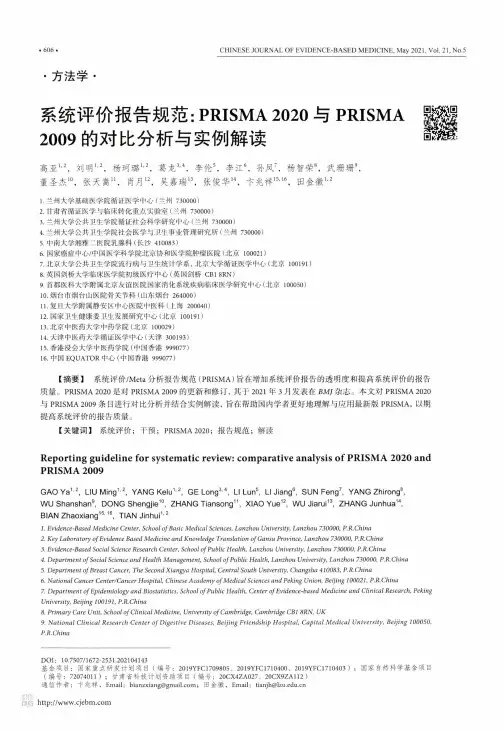
•606. CHINESE JOURNAL OF EVIDENCE-BASED MEDICINE, May 2021, Vol. 21, No.5•方法学•系统评价报告规范:PRISMA2020与PRISMA2009的对比分析与实例解读高亚刘明u,杨珂璐“2,葛龙3’4,李伦5,李江6,孙凤7,杨智荣8,武珊珊9,董圣杰ie,张天嵩",肖月12,吴嘉瑞13,张俊华14,卞兆祥15’16,田金徽U21. 兰州大学基础医学院循证医学中心(兰州730000)2. 甘肃省循证医学与临床转化重点实验室(兰州730000)3. 兰州大学公共卫生学院循证社会科学研究中心(兰州730000)4. 兰州大学公共卫生学院社会医学与卫生事业管理研究所(兰州730000)5. 中南大学湘雅二医院乳腺科(长沙410083)6.国家癌症中心/中国医学科学院北京协和医学院肿瘤医院(北京100021)7. 北京大学公共卫生学院流行病与卫生统计学系,北京大学循证医学中心(北京100191)8. 英国剑桥大学临床医学院初级医疗中心(英国剑桥C B1 8R N)9. 首都医科大学附属北京友谊医院国家消化系统疾病临床医学研究中心(北京100050)10. 烟台市烟台山医院骨关节科(山东烟台264000)11. 复旦大学附属静安区中心医院中医科(上海200040)12. 国家卫生健康委卫生发展研究中心(北京100191)13. 北京中医药大学中药学院(北京100029)14. 天津中医药大学循证医学中心(天津300193)15. 香港浸会大学中医药学院(中国香港999077)16. 中国E Q U A T O R中心(中国香港999077)【摘要】系统评价/M eta分析报告规范(PRISMA)旨在增加系统评价报告的透明度和提高系统评价的报告质量。
PRISMA 2020是对PRISMA 2009的更新和修订,其于2021年3月发表在杂志。

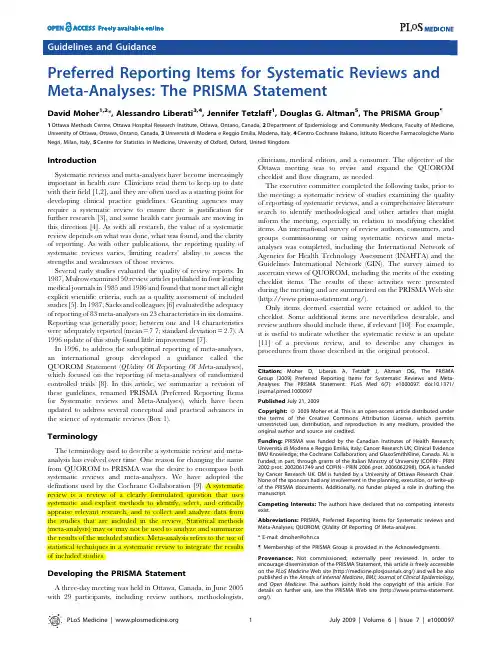
1Preferred Reporting Items for Systematic Reviews and Meta-Analyses:The PRISMA StatementDavid Moher1,2*,Alessandro Liberati3,4,Jennifer Tetzlaff1,Douglas G.Altman5,The PRISMA Group"1Ottawa Methods Centre,Ottawa Hospital Research Institute,Ottawa,Ontario,Canada,2Department of Epidemiology and Community Medicine,Faculty of Medicine, University of Ottawa,Ottawa,Ontario,Canada,3Universita`di Modena e Reggio Emilia,Modena,Italy,4Centro Cochrane Italiano,Istituto Ricerche Farmacologiche Mario Negri,Milan,Italy,5Centre for Statistics in Medicine,University of Oxford,Oxford,United KingdomIntroductionSystematic reviews and meta-analyses have become increasingly important in health care.Clinicians read them to keep up to date with their field[1,2],and they are often used as a starting point for developing clinical practice guidelines.Granting agencies may require a systematic review to ensure there is justification for further research[3],and some health care journals are moving in this direction[4].As with all research,the value of a systematic review depends on what was done,what was found,and the clarity of reporting.As with other publications,the reporting quality of systematic reviews varies,limiting readers’ability to assess the strengths and weaknesses of those reviews.Several early studies evaluated the quality of review reports.In 1987,Mulrow examined50review articles published in four leading medical journals in1985and1986and found that none met all eight explicit scientific criteria,such as a quality assessment of included studies[5].In1987,Sacks and colleagues[6]evaluated the adequacy of reporting of83meta-analyses on23characteristics in six domains. Reporting was generally poor;between one and14characteristics were adequately reported(mean=7.7;standard deviation=2.7).A 1996update of this study found little improvement[7].In1996,to address the suboptimal reporting of meta-analyses, an international group developed a guidance called the QUOROM Statement(QU ality O f R eporting O f M eta-analyses), which focused on the reporting of meta-analyses of randomized controlled trials[8].In this article,we summarize a revision of these guidelines,renamed PRISMA(Preferred Reporting Items for Systematic reviews and Meta-Analyses),which have been updated to address several conceptual and practical advances in the science of systematic reviews(Box1).TerminologyThe terminology used to describe a systematic review and meta-analysis has evolved over time.One reason for changing the name from QUOROM to PRISMA was the desire to encompass both systematic reviews and meta-analyses.We have adopted the definitions used by the Cochrane Collaboration[9].A systematic review is a review of a clearly formulated question that uses systematic and explicit methods to identify,select,and critically appraise relevant research,and to collect and analyze data from the studies that are included in the review.Statistical methods (meta-analysis)may or may not be used to analyze and summarize the results of the included studies.Meta-analysis refers to the use of statistical techniques in a systematic review to integrate the results of included studies.Developing the PRISMA StatementA three-day meeting was held in Ottawa,Canada,in June2005 with29participants,including review authors,methodologists,clinicians,medical editors,and a consumer.The objective of the Ottawa meeting was to revise and expand the QUOROM checklist and flow diagram,as needed.The executive committee completed the following tasks,prior to the meeting:a systematic review of studies examining the quality of reporting of systematic reviews,and a comprehensive literature search to identify methodological and other articles that might inform the meeting,especially in relation to modifying checklist items.An international survey of review authors,consumers,and groups commissioning or using systematic reviews and meta-analyses was completed,including the International Network of Agencies for Health Technology Assessment(INAHTA)and the Guidelines International Network(GIN).The survey aimed to ascertain views of QUOROM,including the merits of the existing checklist items.The results of these activities were presented during the meeting and are summarized on the PRISMA Web site (/).Only items deemed essential were retained or added to the checklist.Some additional items are nevertheless desirable,and review authors should include these,if relevant[10].For example, it is useful to indicate whether the systematic review is an update [11]of a previous review,and to describe any changes in procedures from those described in the original protocol. Citation:Moher D,Liberati A,Tetzlaff J,Altman DG,The PRISMA Group(2009)Preferred Reporting Items for Systematic Reviews and Meta-Analyses:The PRISMA Statement.PLoS Med6(7):e1000097.doi:10.1371/ journal.pmed.1000097Published July21,2009Copyright:ß2009Moher et al.This is an open-access article distributed under the terms of the Creative Commons Attribution License,which permits unrestricted use,distribution,and reproduction in any medium,provided the original author and source are credited.Funding:PRISMA was funded by the Canadian Institutes of Health Research; Universita`di Modena e Reggio Emilia,Italy;Cancer Research UK;Clinical Evidence BMJ Knowledge;the Cochrane Collaboration;and GlaxoSmithKline,Canada.AL is funded,in part,through grants of the Italian Ministry of University(COFIN-PRIN 2002prot.2002061749and COFIN-PRIN2006prot.2006062298).DGA is funded by Cancer Research UK.DM is funded by a University of Ottawa Research Chair. None of the sponsors had any involvement in the planning,execution,or write-up of the PRISMA documents.Additionally,no funder played a role in drafting the manuscript.Competing Interests:The authors have declared that no competing interests exist.Abbreviations:PRISMA,Preferred Reporting Items for Systematic reviews and Meta-Analyses;QUOROM,QU ality O f R eporting O f M eta-analyses. Provenance:Not commissioned;externally peer reviewed.In order to encourage dissemination of the PRISMA Statement,this article is freely accessible on the PLoS Medicine Web site(/)and will be also published in the Annals of Internal Medicine,BMJ,Journal of Clinical Epidemiology, and Open Medicine.The authors jointly hold the copyright of this article.For details on further use,see the PRISMA Web site(http://www.prisma-statement. org/)."Membership of the PRISMA Group is provided in the Acknowledgments.*E-mail:dmoher@ohri.caShortly after the meeting a draft of the PRISMA checklist was circulated to the group,including those invited to the meeting but unable to attend.A disposition file was created containing comments and revisions from each respondent,and the checklist was subsequently revised11times.The group approved the checklist,flow diagram,and this summary paper.Although no direct evidence was found to support retaining or adding some items,evidence from other domains was believed to be relevant.For example,Item5asks authors to provide registration information about the systematic review,including a registration number,if available.Although systematic review registration is not yet widely available[12,13],the participating journals of the International Committee of Medical Journal Editors(ICMJE)[14]now require all clinical trials to be registered in an effort to increase transparency and accountability[15]. Those aspects are also likely to benefit systematic reviewers, possibly reducing the risk of an excessive number of reviews addressing the same question[16,17]and providing greater transparency when updating systematic reviews.The PRISMA StatementThe PRISMA Statement consists of a27-item checklist(Table1; see also Text S1for a downloadable Word template for researchers to re-use)and a four-phase flow diagram(Figure1;see also Figure S1for a downloadable Word template for researchers to re-use). The aim of the PRISMA Statement is to help authors improve the reporting of systematic reviews and meta-analyses.We have focused on randomized trials,but PRISMA can also be used as a basis for reporting systematic reviews of other types of research,particularly evaluations of interventions.PRISMA may also be useful for critical appraisal of published systematic reviews.However,the PRISMA checklist is not a quality assessment instrument to gauge the quality of a systematic review.From QUOROM to PRISMAThe new PRISMA checklist differs in several respects from the QUOROM checklist,and the substantive specific changes are highlighted in Table 2.Generally,the PRISMA checklist ‘‘decouples’’several items present in the QUOROM checklist and,where applicable,several checklist items are linked to improve consistency across the systematic review report.The flow diagram has also been modified.Before including studies and providing reasons for excluding others,the review team must first search the literature.This search results in records. Once these records have been screened and eligibility criteria applied,a smaller number of articles will remain.The number of included articles might be smaller(or larger)than the number of studies,because articles may report on multiple studies and results from a particular study may be published in several articles.To capture this information,the PRISMA flow diagram now requests information on these phases of the review process. EndorsementThe PRISMA Statement should replace the QUOROM State-ment for those journals that have endorsed QUOROM.We hope that other journals will support PRISMA;they can do so by registering on the PRISMA Web site.To underscore to authors,and others,the importance of transparent reporting of systematic reviews,we encourage supporting journals to reference the PRISMA Statement and include the PRISMA Web address in their Instructions to Authors.We also invite editorial organizations to consider endorsing PRISMA and encourage authors to adhere to its principles.The PRISMA Explanation and Elaboration Paper In addition to the PRISMA Statement,a supporting Explana-tion and Elaboration document has been produced[18]following the style used for other reporting guidelines[19–21].The processBox1:Conceptual Issues in the Evolution from QUOROM to PRISMACompleting a Systematic Review Is an Iterative Process The conduct of a systematic review depends heavily on the scope and quality of included studies:thus systematic reviewers may need to modify their original review protocol during its conduct.Any systematic review reporting guideline should recommend that such changes can be reported and explained without suggesting that they are inappropriate.The PRISMA Statement(Items5,11, 16,and23)acknowledges this iterative process.Aside from Cochrane reviews,all of which should have a protocol, only about10%of systematic reviewers report working from a protocol[22].Without a protocol that is publicly accessible,it is difficult to judge between appropriate and inappropriate modifications.Conduct and Reporting Research Are Distinct Concepts This distinction is,however,less straightforward for systematic reviews than for assessments of the reporting of an individual study, because the reporting and conduct of systematic reviews are,by nature,closely intertwined.For example,the failure of a systematic review to report the assessment of the risk of bias in included studies may be seen as a marker of poor conduct,given the importance of this activity in the systematic review process[37].Study-Level Versus Outcome-Level Assessment of Risk of Bias For studies included in a systematic review,a thorough assessment of the risk of bias requires both a ‘‘study-level’’assessment(e.g.,adequacy of allocation concealment)and,for some features,a newer approach called‘‘outcome-level’’assessment.An outcome-level assessment involves evaluating the reliability and validity of the data for each important outcome by determining the methods used to assess them in each individual study [38].The quality of evidence may differ across outcomes, even within a study,such as between a primary efficacy outcome,which is likely to be very carefully and systematically measured,and the assessment of serious harms[39],which may rely on spontaneous reports by investigators.This information should be reported to allow an explicit assessment of the extent to which an estimate of effect is correct[38].Importance of Reporting Biases Different types of reporting biases may hamper the conduct and interpretation of systematic reviews.Selective reporting of complete studies(e.g.,publication bias)[28]as well as the more recently empirically demonstrated‘‘outcome reporting bias’’within individual studies[40,41]should be considered by authors when conducting a systematic review and reporting its results.Though the implications of these biases on the conduct and reporting of systematic reviews themselves are unclear,some previous research has identified that selective outcome reporting may occur also in the context of systematic reviews[42].of completing this document included developing a large database of exemplars to highlight how best to report each checklist item,and identifying a comprehensive evidence base to support the inclusion of each checklist item.The Explanation and Elaboration document was completed after several face to face meetings and numerous iterations among several meeting participants,after which it was shared with the whole group for additional revisions and final approval.Finally,the group formed a dissemination subcommittee to help disseminate and implement PRISMA.DiscussionThe quality of reporting of systematic reviews is still not optimal [22–27].In a recent review of 300systematic reviews,few authors reported assessing possible publication bias [22],even though there is overwhelming evidence both for its existence [28]and its impact on the results of systematic reviews [29].Even when the possibility of publication bias is assessed,there is no guarantee that systematic reviewers have assessed or interpreted it appropriately [30].Although the absence of reporting such an assessment does not necessarily indicate that it was not done,reporting an assessment of possible publication bias is likely to be a marker of the thoroughness of the conduct of the systematic review.Several approaches have been developed to conduct systematic reviews on a broader array of questions.For example,systematicreviews are now conducted to investigate cost-effectiveness [31],diagnostic [32]or prognostic questions [33],genetic associations [34],and policy making [35].The general concepts and topics covered by PRISMA are all relevant to any systematic review,not just those whose objective is to summarize the benefits and harms of a health care intervention.However,some modifications of the checklist items or flow diagram will be necessary in particular circumstances.For example,assessing the risk of bias is a key concept,but the items used to assess this in a diagnostic review are likely to focus on issues such as the spectrum of patients and the verification of disease status,which differ from reviews of interventions.The flow diagram will also need adjustments when reporting individual patient data meta-analysis [36].We have developed an explanatory document [18]to increase the usefulness of PRISMA.For each checklist item,this document contains an example of good reporting,a rationale for its inclusion,and supporting evidence,including references,whenever possible.We believe this document will also serve as a useful resource for those teaching systematic review methodology.We encourage journals to include reference to the explanatory document in their Instructions to Authors.Like any evidence-based endeavor,PRISMA is a living document.To this end we invite readers to comment on the revised version,particularly the new checklist and flow diagram,through the PRISMA Web site.We will use such information to inform PRISMA’s continueddevelopment.Figure 1.Flow of information through the different phases of a systematic review.doi:10.1371/journal.pmed.1000097.g001Table1.Checklist of items to include when reporting a systematic review or meta-analysis.Section/Topic#Checklist Item Reported on Page#TITLETitle1Identify the report as a systematic review,meta-analysis,or both.ABSTRACTStructured summary2Provide a structured summary including,as applicable:background;objectives;data sources;study eligibilitycriteria,participants,and interventions;study appraisal and synthesis methods;results;limitations;conclusionsand implications of key findings;systematic review registration number.INTRODUCTIONRationale3Describe the rationale for the review in the context of what is already known.Objectives4Provide an explicit statement of questions being addressed with reference to participants,interventions,comparisons,outcomes,and study design(PICOS).METHODSProtocol and registration5Indicate if a review protocol exists,if and where it can be accessed(e.g.,Web address),and,if available,provideregistration information including registration number.Eligibility criteria6Specify study characteristics(e.g.,PICOS,length of follow-up)and report characteristics(e.g.,years considered,language,publication status)used as criteria for eligibility,giving rationale.Information sources7Describe all information sources(e.g.,databases with dates of coverage,contact with study authors to identifyadditional studies)in the search and date last searched.Search8Present full electronic search strategy for at least one database,including any limits used,such that it could berepeated.Study selection9State the process for selecting studies(i.e.,screening,eligibility,included in systematic review,and,if applicable,included in the meta-analysis).Data collection process10Describe method of data extraction from reports(e.g.,piloted forms,independently,in duplicate)and anyprocesses for obtaining and confirming data from investigators.Data items11List and define all variables for which data were sought(e.g.,PICOS,funding sources)and any assumptions andsimplifications made.Risk of bias in individual studies 12Describe methods used for assessing risk of bias of individual studies(including specification of whether this was done at the study or outcome level),and how this information is to be used in any data synthesis.Summary measures13State the principal summary measures(e.g.,risk ratio,difference in means).Synthesis of results14Describe the methods of handling data and combining results of studies,if done,including measures ofconsistency(e.g.,I2)for each meta-analysis.Risk of bias across studies15Specify any assessment of risk of bias that may affect the cumulative evidence(e.g.,publication bias,selectivereporting within studies).Additional analyses16Describe methods of additional analyses(e.g.,sensitivity or subgroup analyses,meta-regression),if done,indicating which were pre-specified.RESULTSStudy selection17Give numbers of studies screened,assessed for eligibility,and included in the review,with reasons for exclusionsat each stage,ideally with a flow diagram.Study characteristics18For each study,present characteristics for which data were extracted(e.g.,study size,PICOS,follow-up period)and provide the citations.Risk of bias within studies19Present data on risk of bias of each study and,if available,any outcome-level assessment(see Item12). Results of individual studies20For all outcomes considered(benefits or harms),present,for each study:(a)simple summary data for eachintervention group and(b)effect estimates and confidence intervals,ideally with a forest plot.Synthesis of results21Present results of each meta-analysis done,including confidence intervals and measures of consistency.Risk of bias across studies22Present results of any assessment of risk of bias across studies(see Item15).Additional analysis23Give results of additional analyses,if done(e.g.,sensitivity or subgroup analyses,meta-regression[see Item16]). DISCUSSIONSummary of evidence24Summarize the main findings including the strength of evidence for each main outcome;consider theirrelevance to key groups(e.g.,health care providers,users,and policy makers).Limitations25Discuss limitations at study and outcome level(e.g.,risk of bias),and at review level(e.g.,incomplete retrieval ofidentified research,reporting bias).Conclusions26Provide a general interpretation of the results in the context of other evidence,and implications for futureresearch.FUNDINGFunding27Describe sources of funding for the systematic review and other support(e.g.,supply of data);role of funders forthe systematic review.doi:10.1371/journal.pmed.1000097.t001Supporting InformationFigure S1Flow of information through the different phases of a systematic review(downloadable template document for researchers to re-use).Found at:doi:10.1371/journal.pmed.1000097.s001(0.08MB DOC)Text S1Checklist of items to include when reporting a systematic review or meta-analysis(downloadable tem-plate document for researchers to re-use).Found at:doi:10.1371/journal.pmed.1000097.s002(0.04MB DOC)AcknowledgmentsThe following people contributed to the PRISMA Statement:Doug Altman,DSc,Centre for Statistics in Medicine(Oxford,UK);Gerd Antes,PhD,University Hospital Freiburg(Freiburg,Germany);David Atkins,MD,MPH,Health Services Research and Development Service, Veterans Health Administration(Washington, D. C.,US);Virginia Barbour,MRCP,DPhil,PLoS Medicine(Cambridge,UK);Nick Barrow-man,PhD,Children’s Hospital of Eastern Ontario(Ottawa,Canada); Jesse A.Berlin,ScD,Johnson&Johnson Pharmaceutical Research and Development(Titusville,New Jersey,US);Jocalyn Clark,PhD,PLoS Medicine(at the time of writing,BMJ,London,UK);Mike Clarke,PhD, UK Cochrane Centre(Oxford,UK)and School of Nursing and Midwifery,Trinity College(Dublin,Ireland);Deborah Cook,MD, Departments of Medicine,Clinical Epidemiology and Biostatistics, McMaster University(Hamilton,Canada);Roberto D’Amico,PhD, Universita`di Modena e Reggio Emilia(Modena,Italy)and Centro Cochrane Italiano,Istituto Ricerche Farmacologiche Mario Negri (Milan,Italy);Jonathan J.Deeks,PhD,University of Birmingham (Birmingham,UK);P.J.Devereaux,MD,PhD,Departments of Medicine,Clinical Epidemiology and Biostatistics,McMaster University (Hamilton,Canada);Kay Dickersin,PhD,Johns Hopkins Bloomberg School of Public Health(Baltimore,Maryland,US);Matthias Egger, MD,Department of Social and Preventive Medicine,University of Bern (Bern,Switzerland);Edzard Ernst,MD,PhD,FRCP,FRCP(Edin), Peninsula Medical School(Exeter,UK);Peter C.Gøtzsche,MD,MSc, The Nordic Cochrane Centre(Copenhagen,Denmark);Jeremy Grim-shaw,MBChB,PhD,FRCFP,Ottawa Hospital Research Institute (Ottawa,Canada);Gordon Guyatt,MD,Departments of Medicine, Clinical Epidemiology and Biostatistics,McMaster University(Hamilton, Canada);Julian Higgins,PhD,MRC Biostatistics Unit(Cambridge,UK); John P.A.Ioannidis,MD,University of Ioannina Campus(Ioannina, Greece);Jos Kleijnen,MD,PhD,Kleijnen Systematic Reviews Ltd (York,UK)and School for Public Health and Primary Care(CAPHRI), University of Maastricht(Maastricht,Netherlands);Tom Lang,MA, Tom Lang Communications and Training(Davis,California,US); Alessandro Liberati,MD,Universita`di Modena e Reggio Emilia (Modena,Italy)and Centro Cochrane Italiano,Istituto Ricerche Farmacologiche Mario Negri(Milan,Italy);Nicola Magrini,MD,NHS Centre for the Evaluation of the Effectiveness of Health Care–CeVEAS (Modena,Italy);David McNamee,PhD,The Lancet(London,UK); Lorenzo Moja,MD,MSc,Centro Cochrane Italiano,Istituto Ricerche Farmacologiche Mario Negri(Milan,Italy);David Moher,PhD,Ottawa Methods Centre,Ottawa Hospital Research Institute(Ottawa,Canada); Cynthia Mulrow,MD,MSc,Annals of Internal Medicine(Philadelphia, Pennsylvania,US);Maryann Napoli,Center for Medical Consumers (New York,New York,US);Andy Oxman,MD,Norwegian Health Services Research Centre(Oslo,Norway);Ba’Pham,MMath,Toronto Health Economics and Technology Assessment Collaborative(Toronto, Canada)(at the time of the first meeting of the group,GlaxoSmithKline Canada,Mississauga,Canada);Drummond Rennie,MD,FRCP,FACP, University of California San Francisco(San Francisco,California,US); Margaret Sampson,MLIS,Children’s Hospital of Eastern Ontario (Ottawa,Canada);Kenneth F.Schulz,PhD,MBA,Family Health International(Durham,North Carolina,US);Paul G.Shekelle,MD, PhD,Southern California Evidence Based Practice Center(Santa Monica,California,US);Jennifer Tetzlaff,BSc,Ottawa Methods Centre,Ottawa Hospital Research Institute(Ottawa,Canada);David Tovey,FRCGP,The Cochrane Library,Cochrane CollaborationTable2.Substantive specific changes between the QUOROM checklist and the PRISMA checklist(a tick indicates the presence of the topic in QUOROM or PRISMA).Section/Topic Item QUOROM PRISMA CommentAbstract!!QUOROM and PRISMA ask authors to report an abstract.However,PRISMA is notspecific about format.Introduction Objective!This new item(4)addresses the explicit question the review addresses using the PICOreporting system(which describes the participants,interventions,comparisons,andoutcome(s)of the systematic review),together with the specification of the type ofstudy design(PICOS);the item is linked to Items6,11,and18of the checklist. Methods Protocol!This new item(5)asks authors to report whether the review has a protocol and if sohow it can be accessed.Methods Search!!Although reporting the search is present in both QUOROM and PRISMA checklists,PRISMA asks authors to provide a full description of at least one electronic searchstrategy(Item8).Without such information it is impossible to repeat the authors’search.Methods Assessment ofrisk of bias inincluded studies !!Renamed from‘‘quality assessment’’in QUOROM.This item(12)is linked withreporting this information in the results(Item19).The new concept of‘‘outcome-level’’assessment has been introduced.Methods Assessment ofrisk of bias acrossstudies !This new item(15)asks authors to describe any assessments of risk of bias in the review,such as selective reporting within the included studies.This item is linkedwith reporting this information in the results(Item22).Discussion!!Although both QUOROM and PRISMA checklists address the discussion section,PRISMA devotes three items(24–26)to the discussion.In PRISMA the main types oflimitations are explicitly stated and their discussion required.Funding!This new item(27)asks authors to provide information on any sources of funding forthe systematic review.doi:10.1371/journal.pmed.1000097.t002(Oxford,UK)(at the time of the first meeting of the group,BMJ, London,UK);Peter Tugwell,MD,MSc,FRCPC,Institute of Population Health,University of Ottawa(Ottawa,Canada).Author ContributionsICMJE criteria for authorship read and met:DM AL JT DGA.Wrote the first draft of the paper:DM AL DGA.Contributed to the writing of the paper:DM AL JT DGA.Participated in regular conference calls,identified the participants,secured funds,planned the meeting,participated in the meeting,and drafted the manuscript:DM AL DGA.Participated in identifying the evidence base for PRISMA,refining the checklist,and drafting the manuscript:JT.Agree with the recommendations:DM AL JT DGA.References1.Oxman AD,Cook DJ,Guyatt GH(1994)Users’guides to the medical literature.VI.How to use an overview.Evidence-Based Medicine Working Group.JAMA 272:1367–1371.2.Swingler GH,Volmink J,Ioannidis JP(2003)Number of published systematicreviews and global burden of disease:Database analysis.BMJ327:1083–1084.3.Canadian Institutes of Health Research(2006)Randomized controlled trialsregistration/application checklist(12/2006).Available:http://www.cihr-irsc.gc.ca/e/documents/rct_reg_e.pdf.Accessed19May2009.4.Young C,Horton R(2005)Putting clinical trials into ncet366:107.5.Mulrow CD(1987)The medical review article:State of the science.Ann InternMed106:485–488.6.Sacks HS,Berrier J,Reitman D,Ancona-Berk VA,Chalmers TC(1987)Meta-analysis of randomized controlled trials.New Engl J Med316:450–455.7.Sacks HS,Reitman D,Pagano D,Kupelnick B(1996)Meta-analysis:An update.Mt Sinai J Med63:216–224.8.Moher D,Cook DJ,Eastwood S,Olkin I,Rennie D,et al.(1994)Improving thequality of reporting of meta-analysis of randomized controlled trials:The QUOROM ncet354:1896–1900.9.Green S,Higgins J,eds(2005)Glossary.Cochrane handbook for systematicreviews of interventions4.2.5.The Cochrane Collaboration.Available:http:// /resources/glossary.htm.Accessed19May2009.10.Strech D,Tilburt J(2008)Value judgments in the analysis and synthesis ofevidence.J Clin Epidemiol61:521–524.11.Moher D,Tsertsvadze A(2006)Systematic reviews:When is an update anupdate?Lancet367:881–883.12.University of York(2009)Centre for Reviews and Dissemination.Available:/inst/crd/.Accessed19May2009.13.The Joanna Briggs Institute(2008)Protocols&work in progress.Available:.au/pubs/systematic_reviews_prot.php.Accessed 19May2009.14.De Angelis C,Drazan JM,Frizelle FA,Haug C,Hoey J,et al.(2004)Clinicaltrial registration:A statement from the International Committee of Medical Journal Editors.CMAJ171:606–607.15.Whittington CJ,Kendall T,Fonagy P,Cottrell D,Cotgrove A,et al.(2004)Selective serotonin reuptake inhibitors in childhood depression:Systematic review of published versus unpublished ncet363:1341–1345.16.Bagshaw SM,McAlister FA,Manns BJ,Ghali WA(2006)Acetylcysteine in theprevention of contrast-induced nephropathy:A case study of the pitfalls in the evolution of evidence.Arch Intern Med166:161–166.17.Biondi-Zoccai GG,Lotrionte M,Abbate A,Testa L,Remigi E,et al.(2006)Compliance with QUOROM and quality of reporting of overlapping meta-analyses on the role of acetylcysteine in the prevention of contrast associated nephropathy:Case study.BMJ332:202–209.18.Liberati A,Altman DG,Tetzlaff J,Mulrow C,Gøtzsche P,et al.(2009)ThePRISMA statement for reporting systematic reviews and meta-analyses of studies that evaluate health care interventions:Explanation and elaboration.PLoS Med 6:e1000100.doi:10.1371/journal.pmed.1000100.19.Altman DG,Schulz KR,Moher D,Egger M,Davidoff F,et al.(2001)Therevised CONSORT statement for reporting randomized trials:Explanation and elaboration.Ann Intern Med134:663–694.20.Bossuyt PM,Reitsma JB,Bruns DE,Gatsonis CA,Glasziou PP,et al.(2003)Towards complete and accurate reporting of studies of diagnostic accuracy:The STARD explanation and elaboration.Ann Intern Med138:W1–W12.21.Vandenbroucke JP,von Elm E,Altman DG,Gøtzsche PC,Mulrow CD,et al.(2007)Strengthening the Reporting of Observational Studies in Epidemiology (STROBE):Explanation and elaboration.Ann Intern Med147:W163–W194.22.Moher D,Tetzlaff J,Tricco AC,Sampson M,Altman DG(2007)Epidemiologyand reporting characteristics of systematic reviews.PLoS Med4:e78.doi:10.1371/journal.pmed.0040078.23.Bhandari M,Morrow F,Kulkarni AV,Tornetta P(2001)Meta-analyses inorthopaedic surgery:A systematic review of their methodologies.J Bone Joint Surg Am83-A:15–24.24.Kelly KD,Travers A,Dorgan M,Slater L,Rowe BH(2001)Evaluating thequality of systematic reviews in the emergency medicine literature.Ann Emerg Med38:518–526.25.Richards D(2004)The quality of systematic reviews in dentistry.Evid BasedDent5:17.26.Choi PT,Halpern SH,Malik N,Jadad AR,Tramer MR,et al.(2001)Examining the evidence in anesthesia literature:A critical appraisal of systematic reviews.Anesth Analg92:700–709.27.Delaney A,Bagshaw SM,Ferland A,Manns B,Laupland KB(2005)Asystematic evaluation of the quality of meta-analyses in the critical care literature.Crit Care9:R575–R582.28.Dickersin K(2005)Publication bias:Recognizing the problem,understanding itsorigins and scope,and preventing harm.In:Rothstein HR,Sutton AJ, Borenstein M,eds.Publication bias in meta-analysis-Prevention,assessment and adjustments.Chichester(UK):John Wiley&Sons.pp11–33.29.Sutton AJ(2005)Evidence concerning the consequences of publication andrelated biases.In:Rothstein HR,Sutton AJ,Borenstein M,eds.Publication bias in meta-analysis-Prevention,assessment and adjustments.Chichester(UK):John Wiley&Sons.pp175–192.u J,Ioannidis JP,Terrin N,Schmid CH,Olkin I(2006)The case of themisleading funnel plot.BMJ333:597–600.dabaum U,Chopra CL,Huang G,Scheiman JM,Chernew ME,et al.(2001)Aspirin as an adjunct to screening for prevention of sporadic colorectal cancer:A cost-effectiveness analysis.Ann Intern Med135:769–781.32.Deeks JJ(2001)Systematic reviews in health care:Systematic reviews ofevaluations of diagnostic and screening tests.BMJ323:157–162.33.Altman DG(2001)Systematic reviews of evaluations of prognostic variables.BMJ323:224–228.34.Ioannidis JP,Ntzani EE,Trikalinos TA,Contopoulos-Ioannidis DG(2001)Replication validity of genetic association studies.Nat Genet29:306–309. vis J,Davies H,Oxman A,Denis J,Golden-Biddle K,et al.(2005)Towardssystematic reviews that inform health care management and policy-making.J Health Serv Res Policy10:35–48.36.Stewart LA,Clarke MJ(1995)Practical methodology of meta-analyses(overviews)using updated individual patient data.Cochrane Working Group.Stat Med14:2057–2079.37.Moja LP,Telaro E,D’Amico R,Moschetti I,Coe L,et al.(2005)Assessment ofmethodological quality of primary studies by systematic reviews:Results of the metaquality cross sectional study.BMJ330:1053–1055.38.Guyatt GH,Oxman AD,Vist GE,Kunz R,Falck-Ytter Y,et al.(2008)GRADE:An emerging consensus on rating quality of evidence and strength of recommendations.BMJ336:924–926.39.Schunemann HJ,Jaeschke R,Cook DJ,Bria WF,El-Solh AA,et al.(2006)Anofficial ATS statement:Grading the quality of evidence and strength of recommendations in ATS guidelines and recommendations.Am J Respir Crit Care Med174:605–614.40.Chan AW,Hrobjartsson A,Haahr MT,Gøtzsche PC,Altman DG(2004)Empirical evidence for selective reporting of outcomes in randomized trials: Comparison of protocols to published articles.JAMA291:2457–2465.41.Chan AW,Krleza-Jeric K,Schmid I,Altman DG(2004)Outcome reportingbias in randomized trials funded by the Canadian Institutes of Health Research.CMAJ171:735–740.42.Silagy CA,Middleton P,Hopewell S(2002)Publishing protocols of systematicreviews:Comparing what was done to what was planned.JAMA287: 2831–2834.。
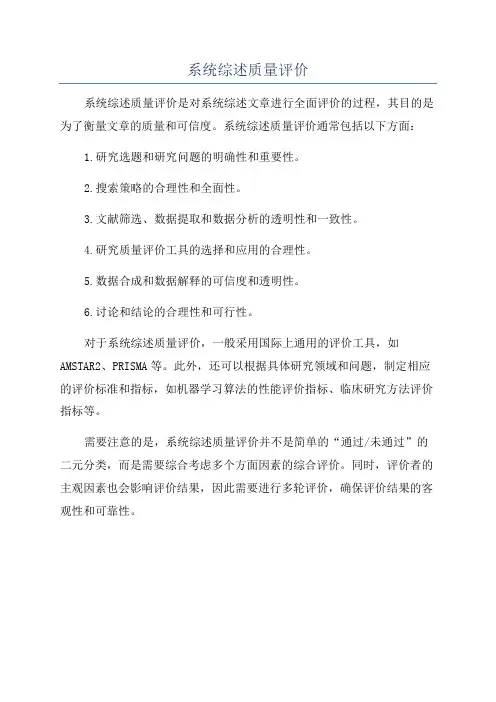
系统综述质量评价
系统综述质量评价是对系统综述文章进行全面评价的过程,其目的是为了衡量文章的质量和可信度。
系统综述质量评价通常包括以下方面:
1.研究选题和研究问题的明确性和重要性。
2.搜索策略的合理性和全面性。
3.文献筛选、数据提取和数据分析的透明性和一致性。
4.研究质量评价工具的选择和应用的合理性。
5.数据合成和数据解释的可信度和透明性。
6.讨论和结论的合理性和可行性。
对于系统综述质量评价,一般采用国际上通用的评价工具,如AMSTAR2、PRISMA等。
此外,还可以根据具体研究领域和问题,制定相应的评价标准和指标,如机器学习算法的性能评价指标、临床研究方法评价指标等。
需要注意的是,系统综述质量评价并不是简单的“通过/未通过”的二元分类,而是需要综合考虑多个方面因素的综合评价。
同时,评价者的主观因素也会影响评价结果,因此需要进行多轮评价,确保评价结果的客观性和可靠性。
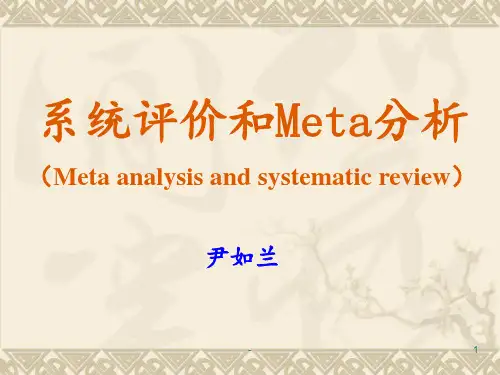
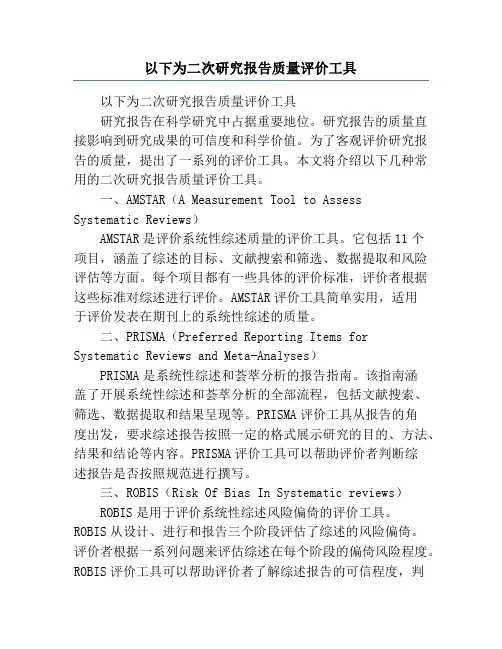
以下为二次研究报告质量评价工具以下为二次研究报告质量评价工具研究报告在科学研究中占据重要地位。
研究报告的质量直接影响到研究成果的可信度和科学价值。
为了客观评价研究报告的质量,提出了一系列的评价工具。
本文将介绍以下几种常用的二次研究报告质量评价工具。
一、AMSTAR(A Measurement Tool to AssessSystematic Reviews)AMSTAR是评价系统性综述质量的评价工具。
它包括11个项目,涵盖了综述的目标、文献搜索和筛选、数据提取和风险评估等方面。
每个项目都有一些具体的评价标准,评价者根据这些标准对综述进行评价。
AMSTAR评价工具简单实用,适用于评价发表在期刊上的系统性综述的质量。
二、PRISMA(Preferred Reporting Items for Systematic Reviews and Meta-Analyses)PRISMA是系统性综述和荟萃分析的报告指南。
该指南涵盖了开展系统性综述和荟萃分析的全部流程,包括文献搜索、筛选、数据提取和结果呈现等。
PRISMA评价工具从报告的角度出发,要求综述报告按照一定的格式展示研究的目的、方法、结果和结论等内容。
PRISMA评价工具可以帮助评价者判断综述报告是否按照规范进行撰写。
三、ROBIS(Risk Of Bias In Systematic reviews)ROBIS是用于评价系统性综述风险偏倚的评价工具。
ROBIS从设计、进行和报告三个阶段评估了综述的风险偏倚。
评价者根据一系列问题来评估综述在每个阶段的偏倚风险程度。
ROBIS评价工具可以帮助评价者了解综述报告的可信程度,判断是否存在风险偏倚。
四、COSMIN(Consensus-based Standards for the Selection of Health Measurement Instruments)COSMIN是用于评价测量工具质量的评价工具。

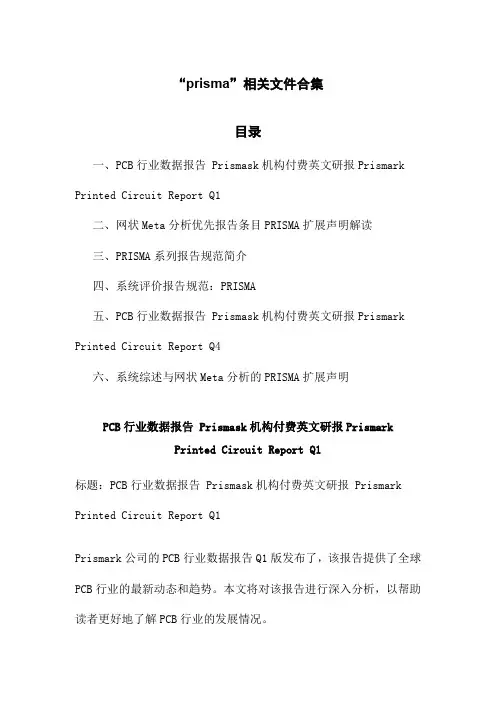
“prisma”相关文件合集目录一、PCB行业数据报告 Prismask机构付费英文研报Prismark Printed Circuit Report Q1二、网状Meta分析优先报告条目PRISMA扩展声明解读三、PRISMA系列报告规范简介四、系统评价报告规范:PRISMA五、PCB行业数据报告 Prismask机构付费英文研报Prismark Printed Circuit Report Q4六、系统综述与网状Meta分析的PRISMA扩展声明PCB行业数据报告 Prismask机构付费英文研报PrismarkPrinted Circuit Report Q1标题:PCB行业数据报告 Prismask机构付费英文研报 Prismark Printed Circuit Report Q1Prismark公司的PCB行业数据报告Q1版发布了,该报告提供了全球PCB行业的最新动态和趋势。
本文将对该报告进行深入分析,以帮助读者更好地了解PCB行业的发展情况。
根据Prismark公司的报告,全球PCB市场在2023年第一季度持续增长,但增速较上一季度有所放缓。
这主要是由于全球经济形势的不稳定以及电子消费品市场需求的疲软。
然而,即使在这样的环境下,PCB 行业依然保持了稳健的增长态势。
美洲市场:美洲市场的PCB产值在2023年第一季度实现了同比增长,主要得益于美国和巴西市场的增长。
然而,墨西哥市场的表现却不尽如人意,产值出现了下滑。
欧洲市场:欧洲市场的PCB产值在同期也实现了增长,其中德国、英国和法国是主要的增长市场。
然而,俄罗斯市场的表现却因乌克兰战争的影响而下滑。
亚太市场:亚太市场依然是全球PCB产值最大的区域,占全球总产值的近一半。
其中,中国市场的增长最为迅猛,但印度市场的增长速度却相对较慢。
根据报告,多层板市场依然是最大的PCB市场,但增速较慢。
而柔性板市场的增速则相对较快,主要得益于智能手机和可穿戴设备的市场需求增长。
